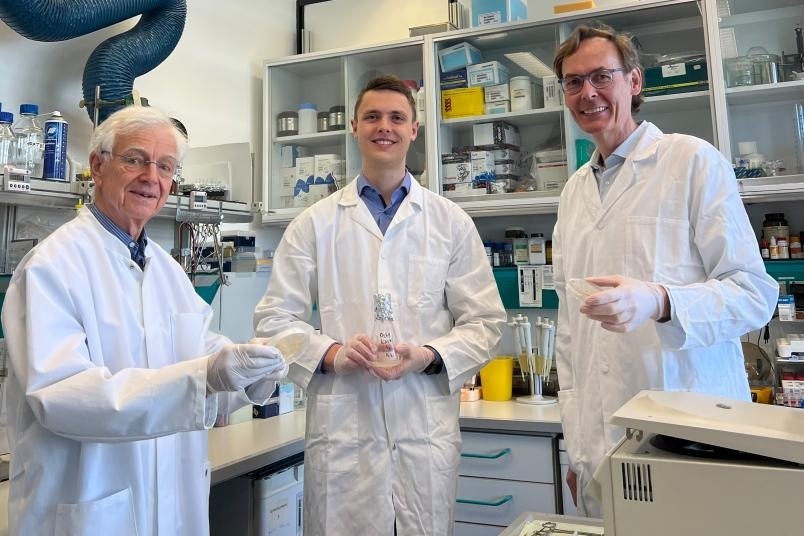Reviewed by Lexie CornerMay 29 2025
The human protein DNase1, used in treatments for conditions such as cystic fibrosis, is currently produced only in mammalian cells, which is both labor-intensive and expensive.
 Hans Georg Mannherz, Jan-Ole Krischek, and Markus Napirei (from left) worked for several years to induce a yeast fungus to produce human DNase1. Image Credit: privat
Hans Georg Mannherz, Jan-Ole Krischek, and Markus Napirei (from left) worked for several years to induce a yeast fungus to produce human DNase1. Image Credit: privat
DNase1 is one of the earliest biological treatments still in use, available since 1958. Today, it is made in immortalized hamster cells, a process that requires a lot of effort and comes with high production costs. Using yeast cells instead could offer a simpler and more affordable alternative.
This is the result of years of work, and could lay the groundwork for the manufacture of human DNase1 in yeast as a biological agent.
Dr. Markus Napirei, Professor, Ruhr University Bochum
These findings were published in the journal PLOS One on April 29, 2025.
Popular Aids
The yeast species Pichia pastoris is already widely used to produce therapeutic proteins. Scientists introduce the genetic instructions for a desired protein into yeast cells using an electric pulse and a synthetic DNA molecule. The yeast then incorporates this DNA into its own genome, reads the code, and produces the target protein.
Napirei added, “The advantages of yeast over mammalian cells are cost-effective culture conditions, a high rate of reproduction without the need to immortalize cells, and lower susceptibility to pathogens.”
As part of his doctoral research, Jan-Ole Krischek, supervised by Napirei and Professor Hans Georg Mannherz, was the first to successfully express, purify, and analyze human DNase1 in Pichia pastoris. However, the team found that the yeast produced much less human DNase1 than the mouse version used for comparison, even though the two proteins are 82 % structurally similar.
“This is partly due to the specific folding behaviors of the two proteins,” noted Napirei.
Mouse DNase1 serves as a model for designing modified forms of human DNase1, which are currently being developed for medical use. This work was led for the first time by Professor Beate Brand-Saberi from the Department of Anatomy and Molecular Embryology at Ruhr University Bochum.
A Lucrative Tool
DNase1 is a protein naturally found in body fluids and secretions. Its job is to break down free-floating DNA, allowing the body to either remove or reuse it. DNA can be released from both the body’s own cells and from microbes, and in some cases, this can lead to health problems, such as in cystic fibrosis, where thick mucus in the lungs contains high levels of DNA.
Since 1993, human DNase1 has been produced using hamster ovary cells and sold as a treatment. When inhaled, DNase1 helps thin the thick, DNA-rich mucus in the lungs, making it easier to clear out by coughing.
DNase1 may also help in other processes where the body needs to remove excess DNA. One example is the clearance of neutrophil extracellular traps (NETs), which are web-like structures released by immune cells to trap bacteria. In severe conditions like sepsis or serious COVID-19 infections, the body can produce too many NETs, leading to harmful blood clots (microthrombi) that contain large amounts of DNA.
“It could be useful to use DNase1 to better dissolve these microthrombi that contain DNA,” suggested Napirei.
Researchers are also studying whether DNase1 can help break down clots in the brain caused by ischemic stroke. This potential use is currently being tested in clinical trials.
Source:
Journal reference:
Krischek, J-O. et al. (2025) Different results despite high homology: Comparative expression of human and murine DNase1 in Pichia pastoris. PLoS ONE. doi.org/10.1371/journal.pone.0321094.